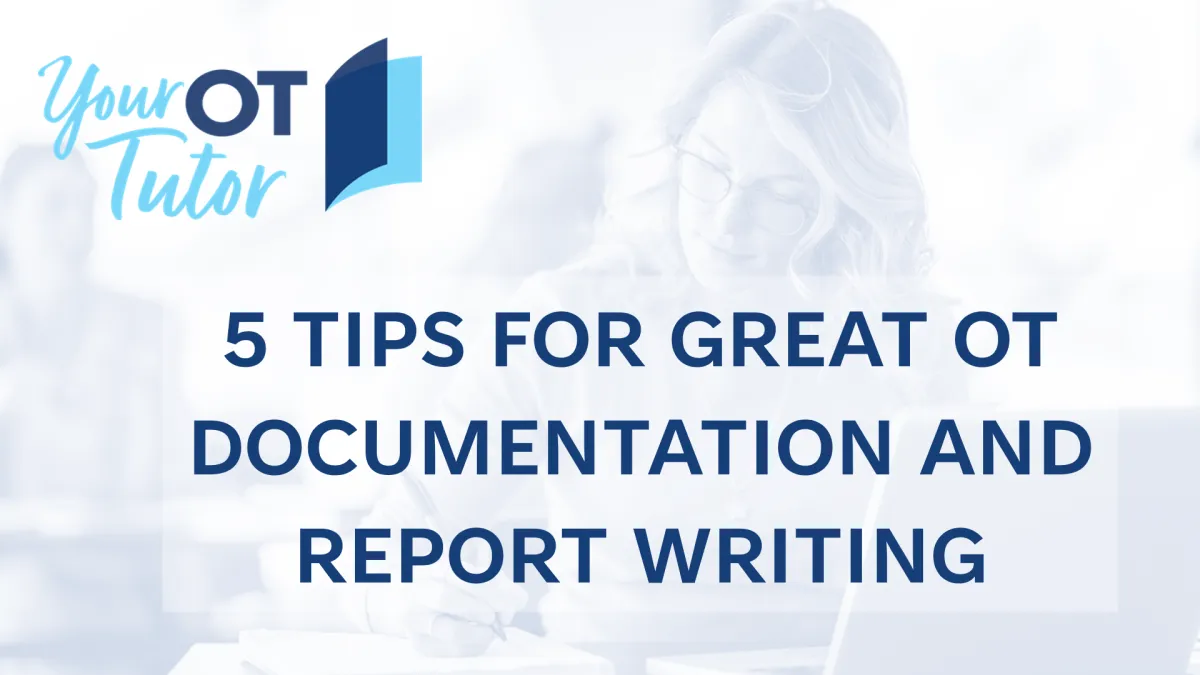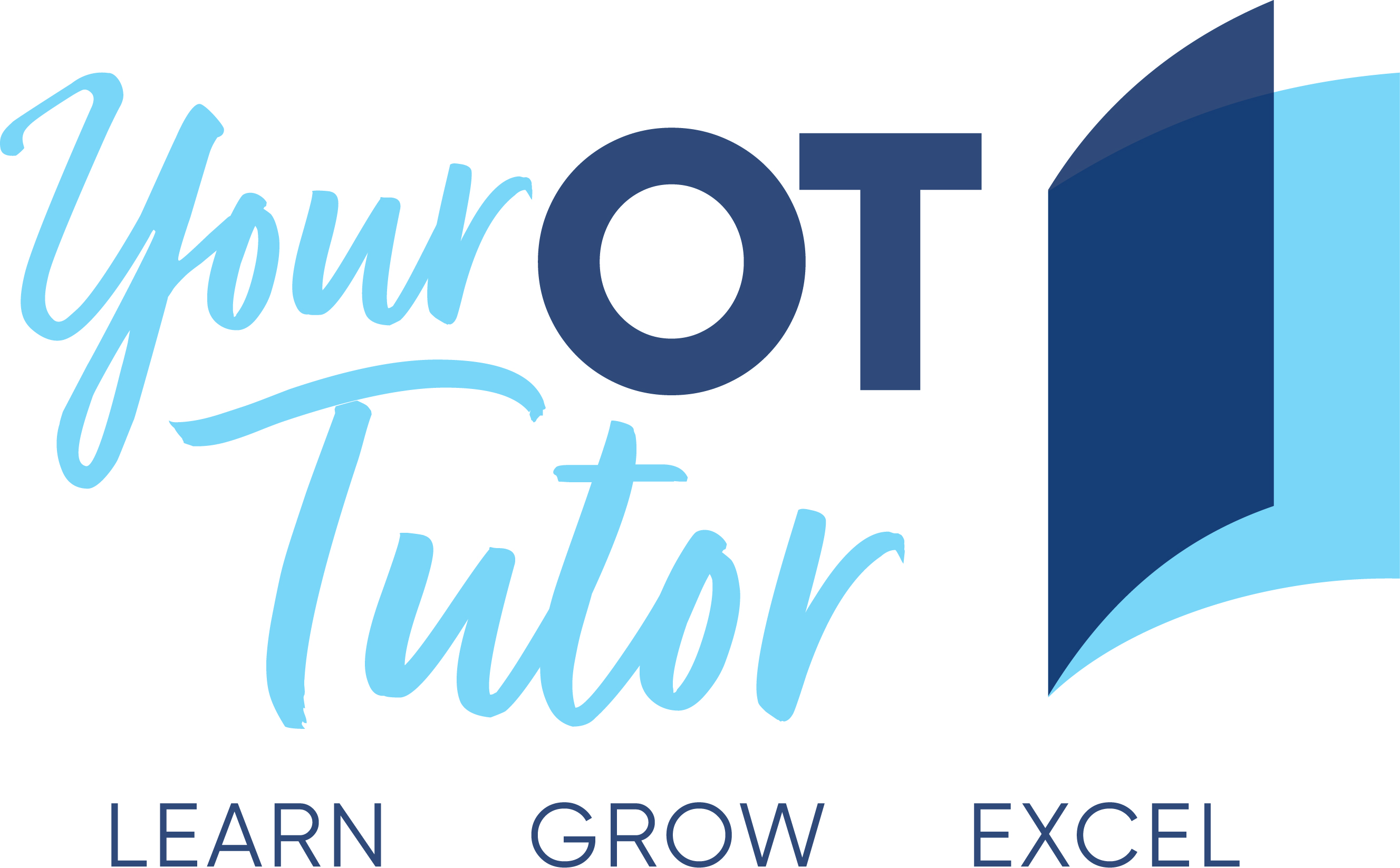THE YOUR OT TUTOR BLOG
Articles on important topics for occupational therapists...

5 TIPS FOR GREAT OT DOCUMENTATION AND REPORT WRITING
Documentation and report writing is a core skill required by any occupational therapist, although the type and amount of documentation will vary with each caseload. OTs need to be able to produce good quality documentation and reports in an efficient manner for a variety of reasons, such as making recommendations and providing handover, or as a legal record of our interactions with our clients. The following 5 tips can be applied across any caseload, to help you improve the efficiency and quality of your documentation and report writing.
Tip 1: Know the purpose of the documentation or report
The content of what you are writing is dependent on the purpose of your documentation or report. You may be writing about the same client interaction or recommendation, but the information you include and how you write it will vary based on what you are trying to achieve with the report, as well as who is reading it (we cover this in the next tip!). Let’s go through some examples:
HOSPITAL DOCUMENTATION:
- Day-to-day hospital documentation has the primary purpose of being a chronological record of interactions with the patient, to be kept as a legal document. But, it can also serve as a clinical handover for others in the multidisciplinary team. To achieve the purpose of being a legal document, it should be written legibly (if hand-written) with any corrections or additions clearly marked and initialled so it is evident when the changes were made. This is different to a report where you only want to keep the final version without edits. This may be tricky to accept if you are a perfectionist, but documentation of an OT session with a few corrections is going to be much more efficient than aiming for a 100% perfect version to put into the patient’s file.
- Also remember that your documentation serves as a clinical handover so other team members can see what you have done or discussed with the patient, so you need to make sure it is in the file in a timely manner (this is also important for legal requirements). If you end up doing an initial assessment with a client late one afternoon and don’t have time to fully document the assessment, you should still make an entry stating that you have seen the client and what your recommendation is, especially if it’s something like: “OT initial assessment completed, full documentation to be completed 1/7. Pt is NOT SAFE FOR DISCHARGE until further OT R/V tomorrow as will require equipment for discharge.”
PRIVATE SECTOR REPORTS:
- Say you need to write up a detailed report on a person’s functional capacity to help justify the NDIS funding they will need in their next plan. While OTs love to be strength’s focused, if we frame our report like this rather than emphasising the areas of life our client has difficulty with, they won’t receive the funding they need. Instead we actually need to highlight the challenges they experience to justify why funding is needed to help them achieve their goals.
- Also keep in mind that in the private sector, every extra section you add to your report is going to cost the client money. Make sure you provide enough detail to explain your clinical reasoning and justification, but leave out anything that is not relevant to the purpose of the report. For example if writing a recommendation for a particular low-cost product or assistive device, explain why it is needed and how the need is linked to the client’s functional difficulty, but leave out information about who they live with, or what the their full medical history or symptom list is, if it is not relevant to the specific recommendation you are making.
Tip 2: Know the audience for your documentation or report
When writing clinical notes or reports, the language you use is very important, and again will vary depending on who is actually the target audience of your documentation or report. Here’s some more examples:
- In a hospital setting, usually the target audience of your clinical notes, or even discharge summary reports, are other health professionals, such as allied health clinicians, nurses or GPs. This means it is appropriate to use medical terminology and accepted abbreviations (proper medical ones though, not messaging abbreviations and slang only understandable if you’re under the age of 25!) in your report. This will demonstrate your knowledge, ensure the reader knows exactly what you are referring to, and can also save time.
- Contrast this to an OT report, or even an email or letter, in the private sector where the target audience is an NDIS planner or a case manager at an insurance company. Most of the time these readers may not have any health or disability specific knowledge, so loading it up with medical terminology is just going to make it too complicated to read. Instead, you need to use plain language, or terminology specific to the funding body you are working with. Where you do need to include medical terminology, make sure you follow-up with a definition in layman’s term, or a specific example relevant to your client. If you don’t, there is every chance your recommendations will be misunderstood or won’t be followed up at all because it ends up in the ‘too hard’ basket.
Tip 3: Less is more
Let’s face it, everyone working in healthcare is busy. No-one really has the luxury of sitting back with a cup of coffee and reading every single word of a medical file or 20-page report word-for-word, so you need to be succinct and make it easy for the reader to find the important information. Here’s how you can do this:
- Use section headings and sub-headings – no-one wants to read an essay. Make key sections of your notes or reports stand-out so the reader can jump straight to the part that they are looking for.
- Use dot-points and succinct sentences – avoid long-winded paragraphs and sentences and use dot-points to keep your writing succinct and easy to speed read. It is still important that your writing is grammatically correct, especially for formal reports, but in clinical notes you can often be brief and leave out unnecessary filler words to save time (e.g. instead of writing “Patient has a grabrail beside his toilet on the left-hand side”, you could write “Toilet – LHS grabrail in situ” to say the same thing).
- Use summary sections – in all documentation or reports, a summary section may be the only part that the target audience will read, whether it’s a medical intern reading your documentation of a hospital inpatient’s initial assessment, or an NDIS planner reading your 20+ page functional capacity assessment report for your NDIS client. Somewhere in your notes or report – usually at the start or end – have a section labelled “Summary” and ensure this includes the take-home messages about what you did and found out in your assessment or therapy session, and what your recommendation may be. It could be as simple as “Patient below baseline function and not safe for discharge; further OT Ax required 1/7” or a succinct dot-point list of the supports your NDIS participant requires, with more detail in the body of the report.
Tip 4: Use templates!
If you aren’t using templates for your documentation or reports, you’re probably wasting time. Templates aren’t just helpful for formal, 20+ page reports, they can even save you time with your clinical notes from client sessions, even through to writing emails to stakeholders. Here’s why:
- Having templates for formal reports means you don’t waste time fighting formatting to make it look pretty, and it will also mean that there is consistency between all clinicians within your team when documenting the same type of session or writing the same clinical report. Once you have worked out a winning system of what should and shouldn’t be included in a particular clinical note or report, turn it into a template so you’re not starting from scratch each time.
- Once you’ve got a template, if you’re lucky enough to have an admin person or allied health assistant, you may even be able to use their skills and the find/replace function to pre-fill the client’s name and pronouns throughout the report if you build in some placeholders to start with (e.g. have he/she/they in your template, but then use “find and replace” to replace it with the appropriate pronoun only, rather than going through and deleting the irrelevant ones every single time).
- Templates can be helpful for documentation in a hospital setting. If your workplace has moved to electronic medical records, it’s usually possible to have a template built-into the eMR itself, but if not, it may even be that you have the sub-headings saved in a Word document that you can cut and paste into your notes in the eMR then add in the details of the session. Still using paper notes with hand-written entries? For short clinical notes that usually cover the same content, look into whether you can develop a sticker with sub-headings and check boxes that you can fill in and stick into the patient’s file, instead of hand-writing everything (check with your facility’s medical records department first though!).
- Another bonus, for all the fellow OT nerds out there, is that the use of a template means that all OTs will write about similar information in their notes or reports. This is great if needing to complete medical record audits, or even if you want to use the information in medical records as part of low-level research where you report on patient characteristics or trends.
Tip 5: Proof-read your work
The extent that you proof-read your work will again depend on the setting, and the purpose of the documentation or report. All clinical documentation should be legible, but you’re less likely to worry about aesthetics when writing in clinical notes compared to preparing a $2000 report. Why does this matter?
- In an NDIS setting, a simple typo could lead to a long, unnecessary hold-up in your client’s plan finalisation. For example, if you submit a report with the right name but the wrong NDIS number, it could take the NDIS a month to realise the error before coming back to tell you that you need to fix it and re-submit; fair enough, but that could then add more waiting time as that updated report passes its way through the NDIS email network.
- The NDIS is part of the private sector, which at the end of the day, is still based on customer satisfaction. If you produce a report with a spelling error or typo on each page, it may not seem like a big deal, but it could be enough that your client refuses to pay for your report in full, or at all.
Lots of different things to consider! Just remember, documentation and report writing skills will get better with practice, but also keep in mind these tips and seek clinical supervision and feedback when writing something for the first time, to ensure the quality and efficiency of your work.
If you found this post helpful, then follow ‘Your OT Tutor’ or visit the website (https://yott.au) and sign-up to the mailing list – there will be more helpful tips and online learning opportunities to come throughout 2023!
#YourOTTutor #OccupationalTherapy #NDIS #ReportWriting






